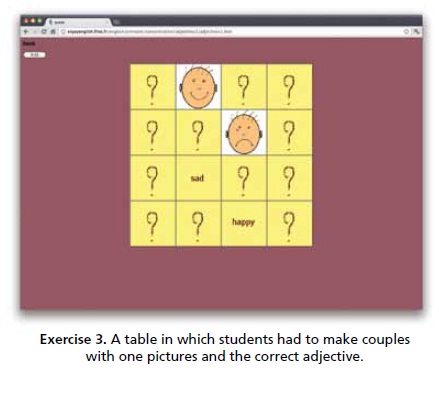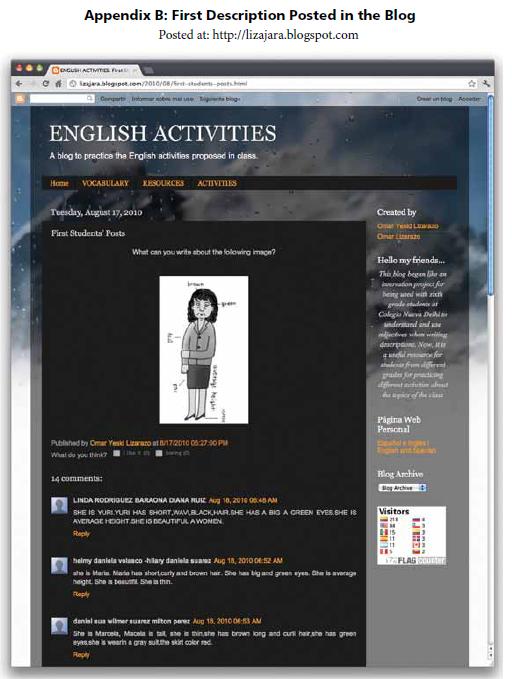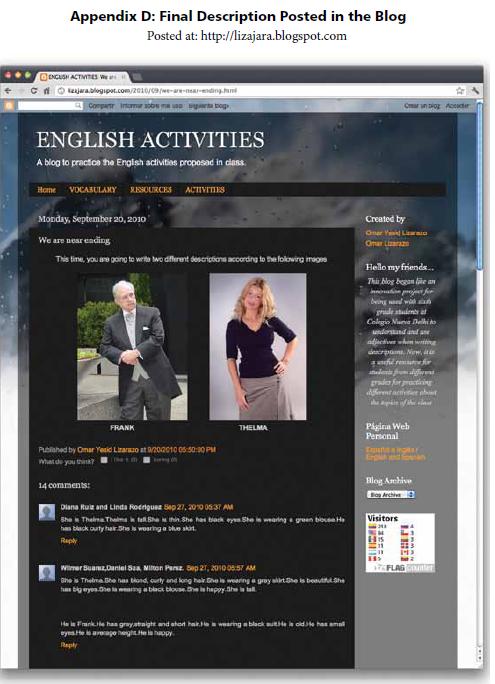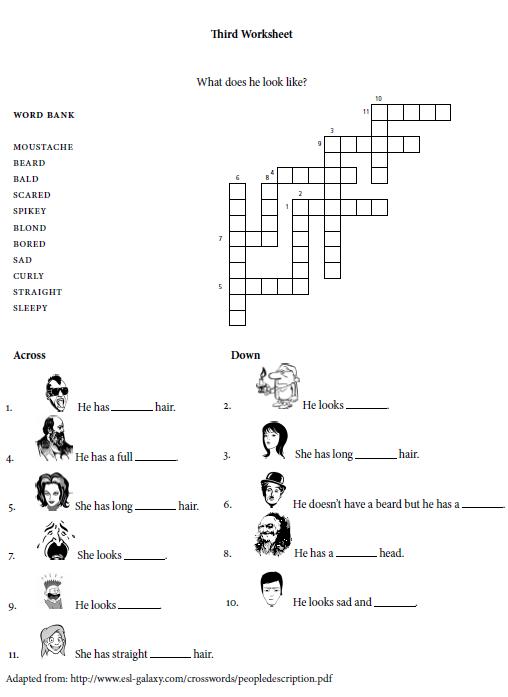Servicios Personalizados
Revista
Articulo
Indicadores
-
 Citado por SciELO
Citado por SciELO -
 Accesos
Accesos
Links relacionados
-
 Citado por Google
Citado por Google -
 Similares en
SciELO
Similares en
SciELO -
 Similares en Google
Similares en Google
Compartir
Profile Issues in Teachers` Professional Development
versión impresa ISSN 1657-0790
profile v.14 n.1 Bogotá ene./jun. 2012
Using a Blog to Guide Beginner Students to Use Adjectives Appropriately
When Writing Descriptions in English*
El uso de una bitácora o blog para guiar a estudiantes principiantes en el uso apropiado de los adjetivos
cuando escriben descripciones en inglés
Omar Yesid Lizarazo Jara
Nueva Delhi School, Colombia
olizaraz@etb.net.co
This paper was received on July 1, 2011 and accepted on December 14, 2011
Beginner students often have difficulties using adjectives when they write descriptions in English. This article focuses on the procedures used to help my sixth grade students understand and use adjectives in the correct order by using a blog. To achieve the objective of the project I decided to implement an innovation in and out of class practices, particularly when guiding students in writing descriptions. Hence, different activities were designed using some worksheets during the lessons in the classroom and some exercises implemented in a blog. The results showed that at the end of the implementation the majority of students' descriptions improved in terms of using adjectives related to nouns and the students increased their understanding of the use of this grammar issue.
Key words: Using adjectives, using blogs, writing descriptions.
Los estudiantes principiantes suelen tener dificultades en el uso de los adjetivos cuando escriben descripciones en inglés. Este artículo se centra en los procedimientos usados con el fin de lograr que mis estudiantes de grado sexto entendieran y emplearan los adjetivos de manera correcta, mediante el uso de una bitácora o blog. Para lograr este objetivo decidí implementar una innovación en las prácticas dentro y fuera de clase, particularmente en la guía brindada a los estudiantes para escribir descripciones. Consecuentemente, se diseñaron diversas actividades que incluyeron guías de trabajo para realizar durante las clases y algunos ejercicios para desarrollar en un blog. Los resultados mostraron que la mayoría de las descripciones escritas por los estudiantes mejoraron en términos de uso de los adjetivos en relación con los sustantivos descritos y, asimismo, que los estudiantes incrementaron su entendimiento respecto al uso de esta categoría gramatical.
Palabras clave: escritura de descripciones, uso de adjetivos, uso de blogs.
Introduction
During the process of English learning, 6thgrade students at Colegio Nueva Delhi I.E.D. have difficulties using adjectives when they write a description. It means that they write the adjective after the noun as we do when we write in Spanish, without taking into account that some structures are formed differently in English. For this reason, some activities were designed to take advantage of the use of blogs and different worksheets, which allowed the students to understand and use the adjectives in English. With these activities, I hoped they could improve their abilities to use adjectives when writing a description in English about people's physical appearances.
Some of the students of the target group seemed to be enthusiastic about English lessons, but most of them were not interested in the class. For this reason I thought that the use of Internet resources in English classes would be a motivating factor for them. This way, I tried to help them to solve this difficulty. Besides, the project was necessary in order to guide students to understand how they have to use adjectives in the correct order in relation to nouns.
In this article the reader will find the objectives and the methodological design of the project including context, type of project and stages. After that, you can find the literature review and finally the data analysis, results and conclusions.
Objectives
The main objective of the study was to analyze how students use adjectives when they write descriptions in English by using a blog. To attain this, the following two specific objectives were posed:
• To engage students in using a blog to understand and use adjectives appropriately when they write descriptions in English about people's physical appearances.
• To observe what happens with students' involvement in the English learning process when they take part in the activities suggested in the blog.
Method
Context
The project was implemented with sixth grade students of the morning shift at Colegio Nueva Delhi I.E.D., which is placed in the fourth locality of the city. The ages in the group of students observed during this project ranged from 10 to 13 years old. This group of students had a very basic level of English language proficiency which explains why during an English class Spanish was more spoken than the foreign language.
In general terms, this group of students (with some exceptions) was able to write simple expressions by using elements that were memorized. They could write (using simple sentences) their names, numbers, some dates, and other simple information, but did not use writing as a communicative skill. Besides, most of the students did not recognize the structure of the sentence when they wrote physical descriptions; instead, they wrote a list of adjectives and nouns (like an inventory of characteristics), but in the same way as they do in Spanish. This means that students wrote one sentence per line showing one specific characteristic. If the student wanted to write something about five different characteristics, then he/she wrote 5 sentences on five different lines. For example, they wrote This is a car blue; Teacher is eyes brown; The pear is of color green.
Approach
To develop this project, I decided to implement a pedagogical innovation. It is considered an innovation because in the high school referred to no similar activity had ever been implemented. Besides, it is important to take into account that the proposal of this project arose from the analysis of the use of adjectives in some descriptions produced by the students. This fact was considered important because, as White (1988) mentions, innovations are events which take place in a context; they do not occur in isolation. In the same vein, Markee (1997) states that "innovation is a managed process of development whose principal products are teaching (and/or) testing materials, methodological skills, and pedagogical values that are perceived as new by potential adopters" (p. 46).
Students in my school were accustomed to going to the resource center to practice every English class with the same software on the computer, but they always followed a pattern guided by the teachers. This practice does not always produce real new knowledge. I mean, teachers had tested the possibility to use the Internet as a pedagogical resource during the session.
With this innovation, I wanted to change my teaching practice with my 6th grade students in terms of the adoption of a new strategy in which students could be in contact with the Internet and learn at the same time. Besides, it is considered an innovation because it is "perceived as new by an individual or other unit of adoption" (Rogers, 2005, p. 11, in Kirklan & Sutch, 2009, p. 10).
Another important aspect to take into account is that this project was considered an innovation not just for being a new experience in the school, but also because nowadays the education process needs to be reloaded, renewed, etc. As Bransford, Brown and Cocking (2000) comment:
Everyone expects much more from today's schools than was expected 100 years ago. A fundamental tenet of modern learning theory is that different kinds of learning goals require different approaches to instruction (Chapter 3); new goals for education require changes in opportunities to learn. (p. 131)
In my opinion, the use of technology and Internet resources is one of those opportunities that must be promoted by teachers. But, of course, it is necessary that as an innovation, the use of technology should be assumed by teachers as an opportunity for improving teaching and learning because, as stated by Bransford, Brown, & Cocking (2000), "Technology has become an important instrument in education. Computer-based technologies hold great promise both for increasing access to knowledge and as a means of promoting learning" (p. 229).
Stages and Data Collection Techniques
The innovation was implemented in three main stages. The first one was related to the explanation of the use of blogs and resources from the Internet. This part of the project was planned because students had never used Internet resources in any class. It is important to mention that parents and students were informed about the development of the project and of the benefits of its implementation. They expressed their interest in participating. Also, parents gave the teacher permission to use the students' writings to be analyzed in order to produce the final report of the project.
The second stage was dedicated to the comprehension and production of physical descriptions in guided form. In this step, students participated in different workshops (some of them using printed worksheets and others using a blog) in which they identified adjectives and their position in the sentence. At the end of this stage, students produced physical descriptions without the direct guidance of the teacher.
The activities applied during the implementation were part of a cycle in which the teacher observed the use of the worksheets and activities in the blog for redesigning what would be necessary in further stages. This was done in order to tackle the difficulties that arose from the accomplishment of the proposal.
The idea behind using those worksheets was to provide the students with key elements with which to identify the adjectives and their position in the sentence. Besides using worksheets during the classes, we exploited a blog with different activities taken from some web pages, including some designed for the purpose of the project. Moreover, during the whole process the teacher took notes about the observations during the classes and activities done by students in order to have a record which could help to organize the information that was used in the final report. The address of the blog is http://lizajara.blogspot.com
Data were collected and analyzed during the whole implementation process. This activity took place in order to find explanations and to produce the final report and conclusions of the project.
Literature Review
Some aspects about language, descriptions, students' engagement and the use of blogs were consulted. These topics were relevant during the implementation of the project, as can be read below.
Language Structures
When students are learning a new language they rarely think in that foreign language (L2, and in this case, English); they usually think in the mother tongue (L1, in our case, Spanish). It means that students do not use the patterns of the L2. This is a case of interference which, although criticized by several authors, refers to the effect of one language on another. It produces deviations from the norms of either language affecting all levels of language: accent, pronunciation, syntax, morphology, and vocabulary (McArthur, 1992), and, it affects the L2 learning process as well.
When students are learning a foreign language, they tend to transfer to the L2 the structures of their native language. For example, students use the Spanish language structure when they are learning how to use adjectives in descriptions, instead of using the ones that the English language has. This fact causes some difficulties during the acquisition of the new language. The main differences between the first language and the other (English and Spanish) are the lexicon, some structure details and some of the sound patterns (García & Molesworth, 1996). These are some of the most common problems students experience during the English language learning process which can be caused by the little contact with the grammar of the foreign language and the small number of hours which is given to study it in the school curriculum.
Based on the aspects mentioned before, the interest placed in this innovation project was a) to understand what happens concerning the use of adjectives when 6th grade students are guided to write descriptions in English, and b) to help them to improve their abilities when writing a description about people's physical appearances.
Descriptions
As already mentioned, students in this project were guided to work on descriptions in English. "Descriptive writing tells how a person, place, or thing feels, looks, smells, or sounds" (Cramer et al., 1989). With this definition in mind, it was thought that descriptions would give students the opportunity to use adjectives and that through the activities in which they would have to write descriptions, they would improve their abilities in using the correct order of adjectives and nouns in English.
At this point it is relevant to mention the definition and function of adjectives. An adjective is a part of speech or word class chiefly used to modify nouns and as a complement to copular verbs such as "be" and "seem" (Richards, Platt, & Weber, 1985). In this project the use of adjectives in descriptions was focused on attributive characteristics. Nordquist (2010) mentions that there are two main kinds of adjectives: attributive, which normally come right before the noun they qualify, and predicative adjectives, which come after the verb to be or similar verbs such as become and seem.
Students' Engagement
Besides the elements mentioned above, grammar is not the only aspect to consider during the foreign language learning and teaching processes. Berns (1990) mentions that attitudes also influence English language teaching and learning traditions to improve the proficiency level and give learners the opportunity to enlarge and develop the competence that they eventually achieve in the classroom. Hence, it is necessary to consider the methodology used to teach; in addition, students need to be interested in learning the foreign language. Related to this issue, in my school students seem not to be interested in the English class. For this reason, it has been considered important to change some strategies during the English lessons, and one useful element could be the use of Internet resources.
Using Blogs During the English Learning Process
According to Ward (2004, in Quintero, 2008), "a weblog is a website that is updated regularly and organized chronologically according to the date, and in reverse order from most recent entry backwards. Weblogs can also provide decentralized access rights which allow(s) multiple authors" (p. 17). It was then considered that the use of a blog could be very interesting for 6th grade students in Nueva Delhi School because they had never used this resource in any class.
The idea of using a blog was an attempt for motivating students in a different way, so that they could view English language learning as an enjoyable experience. A big group of students did not like speaking English to the teacher during the classes; consequently, it was necessary to find a way to communicate with them by writing. In that sense "blogs provide a communication space that teachers can utilize with students whenever there is a curriculum need to develop writing, share ideas and reflect on work being undertaken in the classroom" (Western Australian Department of Education, 2010). Besides, a blog gives students the opportunity to participate actively in their learning process.
As already mentioned, many students did not like to participate during the English lessons, but it was clear that they had understood the topic. Related to this issue, Cuesta (2010) mentions that students could find a self-controlled scenario in a learning space created by an online environment and assisted by their tutors. This scenario could be developed in the school English resource center and, in some cases, at their homes.
As Barrios (2010) mentions, "students don't tend to write unless they have to" and blogs can be a way to change that. Therefore, teachers need to create the habit of writing and if students are engaged with technology; a blog can be very useful to obtain good results in this project.
The use of blogs is a relatively new tool in the teaching and learning processes, but as Quintero (2008) points out, there are some studies which have shown the advantages of using weblogs to enhance students' writing development. She refers to the ones undertaken by Ward (in 2004) with a group of forty non-native English speakers to establish how weblogs could improve their composition level and the experience developed by Deitering and Huston in 2004 in which a class weblog was created to give students from a geography and film intensive writing course the opportunity to write their own comments about the course content.
Technological resources are attractive for students. For that reason, with the development of this project it was considered that an Internet resource like a blog turns out to be a motivational and productive element in class.
Data Analysis
The data obtained during the implementation of the project were collected in three different phases. In the first one, the teacher explained to students some general aspects about the Internet, so during two classes the topic of the sessions was about the use of the computer, history and characteristics of the Internet, the use of a browser and how to write the posts in a blog. This was done in order to facilitate the comprehension and the use of a blog. During the development of this stage, students also had to write a free description. It was written without the teacher's guidance. Students were asked to write about four different objects: a train, a pear, an airplane and a car. The objective of that description was to observe how students used the adjectives in the sentence to describe a noun.
The second phase of the implementation was dedicated to guiding students to write descriptions on a specific topic to focus the explanations and activities just on that issue. The topic selected was people's physical appearances. In this stage of the project different worksheets were used; some of them were created by the teacher and other adapted from books or Internet web pages. At the same time, the blog designed was used to practice the topics of the English lessons and there students found different exercises created by the teacher and taken from different web pages. In these exercises students found matching activities on which they could work with opposite adjectives and images to relate with words, and writing activities to match the opposites of the adjectives in bold. Exercises 1 to 4 can be found at the blog1 (see samples in Appendix A). After the implementation of this part of the project, students wrote a description which was posted on the blog (see Appendix B).
In the final phase of the project the idea was to correct the problems observed in the final description that was written in the second stage. To do this, the teacher designed some new activities to be used in the blog and applied new worksheets. To do these activities students had to unscramble sentences and complete a text by writing the correct adjective according to one image. Exercises 5 to 8 can be found at http://lizajara.blogspot.com/p/activities.html (see samples in Appendix C). The result of this last activity was presented in a final description that students wrote and posted in the blog (See Appendix D).
The instruments used during this part of the process to collect the data were students' written exercises in their notebooks, in the worksheets and in the blog. Also, the teacher wrote some useful notes as part of the analysis of observations made during the classes; they were not part of the research but clues for writing the final report.
Findings
Taking into account the observations that were made in the different activities and the data gathered while students worked with the worksheets and got engaged in the activities proposed in the blog, I analyzed data to find common patterns and explanations. Table 1 shows the categories that emerged from the analysis of the results.

Exploring the Use of Adjectives to Describe People
As mentioned in the objectives of the project, students needed to understand the importance of adjectives when they wrote a description about people and objects. So they needed to realize that people could talk about one object, but if they added a specific characteristic to that object, the idea about that element immediately changed in people's minds because, as Cramer et al. (1989) mentioned, "adjectives can tell how a noun looks, feels, tastes, sounds, or smells" (p. 150). The features found in this category were analyzed at sentence level -the chunks that characterized students' attempts to produce different descriptions.
Word Order
After students wrote the first description included in the activities planned along the project -their free description about the four objects proposed- it was observed that students' written production contained evidences of wrong uses of adjectives to describe a noun. They wrote sentences as they are written in Spanish, but using words in English. At this point, it should be pointed out that this fact could guide us to a broader analysis of the issues, but the project focused just on adjectives. They had to use the dictionary all the time to write simple sentences. It was probably due to a lack of knowledge of the necessary vocabulary in terms of adjectives or nouns and maybe because students did not know enough about English structures to write a description. For example students wrote2: "The train is the colourblak blue"; "The cart is the color blue"; "The pear has blemish the color green an yellow". Other students wrote sentences like a list of characteristics: "The pear is small, the pear is round". In other examples, students used more words but, again, with errors in the use of adjectives: "The airplane utilize wings. Is of colors yellow red and blue. And is big".
The analysis of descriptions like the ones shown above seemed to evidence that students did not understand the concept of the adjective as a grammar issue and its function in the sentence. Students used adjectives in their descriptions, but the teacher's guidance was necessary to understand how to use them. Furthermore, they seemed to need more practice on writing descriptive texts.
In the second stage, students were guided by the teacher to learn adjectives to be used in their writings. This was done through the application of the first three worksheets (see Appendix 5), and some exercises in the blog. The objective of these activities was to increase the vocabulary that they needed to write the descriptions. With the worksheets, students could write short sentences about a dog, a car and finally different characteristics about people. In the blog they could find games and activities in which they could read and write adjectives in short sentences again.
When students accessed the blog they found, among other activities, games like hangman in which they had to guess the adjective. They could also find a word search in which they had to locate 20 new adjectives and an exercise in which they had to listen to one simple sentence to match with the correct words.
At the end of this second stage, students posted a description about one picture that they found in the blog (see Figure 1). These descriptions showed an important improvement in their writings. They showed that with the application of the activities mentioned above, many students could write the adjectives without using the dictionary, that is to say, with more confidence.
Although students still had spelling errors, many of them wrote the adjectives before the nouns and used complete sentences in short paragraphs. At this moment a majority of students had learned new vocabulary to write descriptions and they could organize sentences with more information than merely writing words to describe colors. It should be noted that in this part of the project students worked in groups of two or three people because they had only 13 computers at the school. Other examples of the sentences produced by the students can be found in the descriptions posted in the blog, such as:
She is Maria. Maria has short, curly and brown hair. She has big and green eyes. She is average height. She is beautifil. She is thin. (Group 1)
She is Maria. Maria has short, wavy and black hair. She has small and green eyes. (Group 2)
As can be seen, some of the students still wrote a list of sentences with some errors in the use of adjectives but they showed an improved use of them, especially in the use of colors. It seemed that students understood how they had to write the descriptions, but it was necessary to reinforce the work in writing short paragraphs. For this reason, two additional worksheets were used to complement the practice of writing descriptions, this time focused on people's physical appearances. After the application of these worksheets, students wrote longer sentences and also wrote ideas in paragraphs, which means that they did not write lists of characteristics or an inventory, as in their first descriptions. In addition, I noticed that they used the vocabulary learned in the first activities.
During this part of the project the teacher had to solve a little confusion about the use of the verbs "is" and "has", because some students wrote sentences like: "He is straight, black and short hair". It was also noticed that many students wrote better sentences such as: "She is Mary. Mary has short, wavy and brown hair. She is thirsty too".
The last assignment proposed to students was that they had to write two descriptions about two different images they found in the blog -a man and a woman. With this final assignment it could be observed that the majority of students wrote a complete description using the adjectives in the correct position related to the noun and writing complete sentences with more information than in previous productions. Descriptions produced by the students were posted in the blog. Some of them can be read as follows:
She is Thelma. She has blond, curly and long hair. She is wearing a gray skirt. She is beautiful. She has big eyes. She is wearing a black blouse. She is happy. She is tall. He is Frank. He has gray, straight and short hair. He is wearing a black suit. He is old. He has small eyes. He is average height. He is happy. (Group 3)
She is Thelma. Thelma is tall. She has blond hair. She is wearing a purple blouse. She is thin. She has black eyes. He is Frank. Frank is tall. He has white hair. He is wearing a black jacket. He is fat. He has black eyes. (Group 4)
It is also important to say that many students wrote their final descriptions taking into account the use of capital letters and they had fewer spelling errors than in their previous descriptions posted in the blog. Also, they wrote more information related to clothes and feelings, as can be read in the following sample:
She is Thelma. Thelma has blond, wavy and long hair. She has black and big eyes. She is tall. She is thin. She is wearing a gray skirt and a blue blouse. She is happy too. He is Frank. Frank has a black suit. He has white, short and staight [straight] hair. He has black small eyes. He is fat. He is also happy. (Group 5)
Usefulness of Worksheets and Activities Posted in the Blog
Teachers and students often use worksheets to revise and practice what has been taught in class. As Wyels (2011) states, worksheets are an effective tool in ongoing efforts to encouraging our students to engage their brains during class.
Nowadays, the Internet offers hundreds of use-ful, well-designed and high quality websites which provide new opportunities for English language learning. In those sites people can find many worksheets designed by teachers who want to share their work with other teachers or students who are interested in using technology to improve their English management or their English teaching methods.
Along the implementation of the project, 5 worksheets were applied; moreover, in the blog students could find different types of activities and resources such as word search, hangman, videos, a song, and matching exercises. These activities were about objects, animals and famous people like singers. During the development of the activities students had to practice the use of many adjectives and their opposites.
The majority of the activities seemed to have been interesting for the students, especially when they had to go to the school resource center to work on the computers. As regards the first two worksheets not all the students finished the activity because they had to look for the words in the dictionary so they spent a lot of time finding the meanings. Concerning the last three worksheets, the situation changed and students seemed to be more confident about their work, probably because they noticed that the teacher did not make as many corrections as in the first activities. Besides, they understood their partner's texts, and were happy to see their own texts on the screen of the computer.
The exercises proposed in the blog were very useful because, as already mentioned, students had never used Internet resources in the English class and they were very interested in solving the activities. In fact, during the lessons in the resource center, some groups of students had difficulties due to the low quantity of computers in the classroom since all the students wanted to do all the activities, but with the agreement of some rules and shifts - like organization of turns to write and respect for everybody's opinions- the issue of disadvantages was solved.
The effectiveness of the activities was reflected in the students' writings in terms of the correct use of adjectives and here I am talking about word order. They commented that the exercises were clear and entertaining; this showed an increase in their motivation during the sessions. Throughout the development of the activities with the worksheets, the students' interest in improving their writings and their concern for improving their performance in the activities could be evidenced. These facts are closely related to their increase in motivation. About this topic, the National Research Council and the Institute of Medicine (NRCIM, 2004) states: "Students enjoy and exert more effort when they are active participants than when they are passive" (p. 50).
Role of the Blog
Teaching and learning resources are increasing all the time and students and teachers have the responsibility to adapt their educational environment to get it moving with technological changes. Blogs are some of those new educational tools that can be used nowadays by teachers and students as a support for reflection on teaching experiences. As Duffy and Bruns (2006) state, a blog offers interaction with reflective comments and also the ability to interlink to related ideas.
The subcategories presented in the following paragraphs will illustrate the students' engagement and progress showing how the educational role of the blog was applied to this innovation project.
Students' Engagement
At the beginning of the project students did not have any idea about what a blog was or how to work in a blog, so the teacher had to dedicate some sessions to show this new tool and to explain the educational benefits that a blog could give to the class and to the students' progress. First of all they had to learn how to access the blog, how to post their own ideas. During the next sessions students' interest increased and they wanted to have more new activities in the blog.
Definitely, the use of the blog was a very attractive strategy for the students and because of its novelty they wanted to work every class in the resource center. However, the main constraint was the one of the group of students who participated in this innovation project: just four of them had a computer in their homes. Since many students do not have computers at home, they had to wait for the English class to work on the activities in the blog.
During the development of the project, students attended lessons in the resource center 5 times, two hours each time. In the classes they were very engaged with the activities. At the beginning they had some problems with the instructions because their English language level was very basic in terms of vocabulary and grammar, but with practice, they got used to the exercises and started recognizing what they had to do.
It is also important to point out that at the beginning of the process, some students tended to have less confidence because they were so shy and thought that they were not good at English. However, at the end of the project a majority of these students showed a higher level of confidence. For that reason I agree with NRCIM (2004) when they mention that "They [students] need to know what it takes to succeed and to believe they can succeed" (p. 35). As result of this, students also wrote good descriptions and during the final two sessions at the resource center, they showed more interest in finishing the activities. Definitely, this level of confidence will be very important for students to be able to achieve future goals in our classes.
It was very interesting to note that during the last lessons which implied using the blog, students carried out the activities practically without asking for help from the teacher. In particular, they liked to work with the videos about adjectives in which they could find the word with its pronunciation as well as the corresponding image. They could also find games like hangman and activities like crosswords and word search. Students commented that after those activities they could solve the exercises more easily.
A blog is an excellent instrument that allows developing many different activities in a website that is visited by the students without the pressure of having to work in the classroom on the same traditional activities. Besides, blogs offer opportunities for students to acquire creative, critical, communicative, and collaborative skills that may be useful to them in both scholarly and professional contexts (Duffy & Bruns, 2006).
Students' Progress
When the innovation was proposed to the students, they had been writing descriptions using the adjectives in an incorrect position related to the nouns. At the end of the project, when they had to write their final descriptions, improvement was evident in the use of the structures and the order of the adjectives. It is very probable that the activities carried out coupled with the exercises designed and used in the blog provided the students with enough information to understand how they had to use the adjectives in their descriptions. This was a very important element in achieving the objectives of innovation.
Students' progress was reflected in the descriptions that they wrote in their final post on the blog and also in their level of confidence when handing in writing exercises. Furthermore, their participation during the class seemed to be higher than at the beginning of the project. Besides, the structures of their texts also improved in terms of fluency - students used more words and longer sentences to get messages across. In this respect, it is important to notice that students were worried about the correct use of singular and plural nouns.
After the implementation of the innovation, students seemed to have clarified ideas concerning the use of the adjectives in a description and as they expressed themselves. By then they had learned many new words to be used in their texts.
They were also happy because they had learned new things about the use of the Internet resources as well as the computer. It means students discovered that technology is very useful in their learning process and they gained confidence in the use of the blogs.
Technology gives the language learner the opportunity to have text, audio, images and video in one place and in the same activity. Students noticed this while they used the blog to practice the topics of the lessons. Likewise, during the development of the project, students used the blog as a means to learn English.
Conclusions and Implications
It is important to start by noting that during the development of the project I focused my attention on a specific topic which was to have students correct the use of adjectives in relation to the nouns. There is no doubt this aspect will deserve new teaching actions and broader analyses in the future, particularly in the area of writing skills and descriptions, among others.
Another fact to reinforce is that the use of technological resources in the classroom is turning into a very useful element to engage students' attention and participation during the English class. It is evident that even though students are very close to the use of computers, a majority of them do not use them for pedagogical purposes. In that sense, the implementation of an innovation becomes a very useful strategy for producing positive change in some students' attitudes. Innovations like the one reported here are particularly useful for those who are not confident about taking part in the English lessons and/or who are not happy with their performance in them.
During the development of this project I noticed that the use of blogs was definitely the most attractive resource with which learners could engage in writing practices. They waited for the English class in order to use the computers in the resource center. However, the low number of computers in that classroom turned into a limitation for carrying out activities individually and thus for working faster.
It was unexpected that the use of the blogs turned into a resource not only for English lessons but also for the Spanish ones because students who participated in the project had relatives in other grades. Since some of these students also attended Spanish lessons with the same teacher, they expressed they would like to learn about that new element in the classes.
Though the use of technology and blogs is well known, the use of this kind of resources is not common in the classroom. In fact, many teachers and students are not familiar with the use of the computer. For these reasons, it is necessary to organize training sessions because they need to be shown how those tools can be used for learning purposes.
It can be concluded that the objectives of the innovation project were reached as evidenced by the majority of students' writings. Nonetheless, it is necessary to continue the process with some students who need to work a little bit more in their descriptions, and in general, in their writing skills. For this reason, the use of innovative proposals in the pedagogical procedures adopted for the English area is an important element that should be taken into account during the design of the curricular programs at school.
On the other hand, it would be useful to design a school project for the Secretary of Education in Bogotá for the purpose of obtaining more and better equipment in the resource center. Furthermore, it is necessary to make provisions for the implementation of new strategies in order to produce the appropriate environment of confidence for students' participation in the English activities. This way, we can embark upon actions to keep them away from the assumption that they are not good at that.
It would then be very important for new researchers to know what the knowledge level about the use of computers is among students. Besides, it is necessary to remember that technology in the world is changing all the time and there are a lot of new strategies, applications and software emerging every day on the Internet. Besides, and in order to save time, it would be very useful to be sure about the applications that can be used in the computers at school such as videos from different web pages or other different links of tools that are often blocked by the Secretary of Education's webmaster. Agile solutions are needed because, in cases like this last one, the teacher has to send the people in charge several e-mails requesting help and this procedure often takes a long time.
Finally, I would like to mention that after the implementation of the project I decided to engage in further professional programs. Hence, I decided to start postgraduate studies in a specialization on technology (Computer Science). This way, I hope to improve and reinforce my knowledge about this topic in order to offer my students more and better elements that can be used not just in English classes, but in Spanish classes too.
* This paper reports on a study conducted by the author while participating in the PROFILE Teacher Development Program at Universidad Nacional de Colombia in 2009-2010. The Teacher Development Program was sponsored by Secretaría de Educación de Bogotá, D.C. Code number: 1576, August 24, 2009.
1 http://lizajara.blogspot.com/p/activities.html
2 Samples presented from now on have not been edited. They were transcribed for this publication, keeping the original form used by students.
References
Barrios, B. (2010). Blogs as writing practice. Retrieved from: http://www.bgsu.edu/cconline/barrios/blogs/write/index.html [ Links ]
Berns, M. (1990). Contexts of competence. Social and cultural considerations in communicative language teaching. New York, NY: Plenum Press. [ Links ]
Bransford, J., Brown, A., & Cocking, R. (2000). How people learn: Brain, mind, experience, and school. Washington, DC: National Academy Press. [ Links ]
Cramer, R., Beers, J., Triplett, W., Najimy, N., Ward, L., Welles, C., & McCarthy, T. (1989). Language. Glenview: Scott Foresman Company. [ Links ]
Cuesta, L. (2010). The design and development of online courses materials: Some features and recommendations. PROFILE Issues in Teachers' Professional Development, 12(1), 181-201. [ Links ]
Duffy, P., & Bruns, A. (2006). The use of blogs, wikis and RSS in education: A conversation of possibilities. In Proceeding Online Learning and Teaching Conference 2006, Brisbane, 31-38. Retrieved from: http://eprints.qut.edu.au/5398/1/5398.pdf [ Links ]
García, M. A., & Molesworth, D. J. (1996). Unravelling Spanglish. A practical guide to language interference. Tunja, Colombia: Universidad Pedagógica y Tecnológica de Colombia. [ Links ]
Kirklan, K., & Sutch, D. (2009). Overcoming the barriers to educational innovation: A literature review. Retrieved From: http://www.Futurelab.Org.Uk/Resources/Documents/Lit_Reviews/Barriers_To_Innovation_Review.Pdf [ Links ]
Markee, N. (1997). Managing curricular innovation. Cambridge: Cambridge University Press. [ Links ]
McArthur, T. (1992). The Oxford companion to the English language. Oxford: University University Press. [ Links ]
National Research Council and the Institute of Medicine. (2004). Engaging schools: Fostering high school students' motivation to learn. Committee on Increasing High School Students' Engagement and Motivation to Learn. Board on Children, Youth, and Families, Division of Behavioral and Social Sciences and Education. Washington, DC: The National Academies Press. [ Links ]
Nordquist, R. (2010). Attributive adjective. Retrieved from: http://grammar.about.com/od/ab/g/attribadjterm.htm [ Links ]
Quintero, L. (2008). Blogging: A way to foster EFL writing. Colombian Applied Linguistics Journal, 10, 7-49. [ Links ]
Richards, J. C., Platt, J., & Weber, H. (1985). Longman dictionary of language teaching of applied linguistics. London: Longman. [ Links ]
Western Australian Department of Education. (2010). Blogs in Education: Resourcing the Curriculum. Retrieved from: http://www.det.wa.edu.au/education/cmis/eval/curriculum/ict/weblogs [ Links ]
White, R. (1988). The ELT curriculum: Design, innovation and management. Oxford, UK: Blackwell Publishing Ltd. [ Links ]
Wyels, C. (2011). Engaging students via in-class worksheets. MAA Online Innovative Teaching Exchange. Mathematical Association of America. Retrieved from http://www.maa.org/t_and_l/exchange/ite11/worksheets.htm [ Links ]
About the Author
Omar Yesid Lizarazo Jara has a BA in Languages, Spanish and English from Universidad Antonio Nariño, Colombia, and is currently studying technology and multimedia at the PG level. He also studied in a professional development program at Universidad Nacional de Colombia. He works as a Spanish and English teacher at Nueva Delhi School in Bogotá (Colombia).
Appendix A: Exercises 1 to 4, Posted in the Blog
Posted at: http://lizajara.blogspot.com
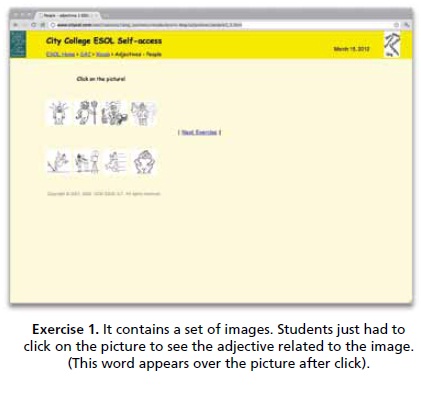


Appendix B: First Description Posted in the Blog
Posted at: http://lizajara.blogspot.com
Appendix C: Exercises 5 to 8, Posted in the Blog
Posted at: http://lizajara.blogspot.com


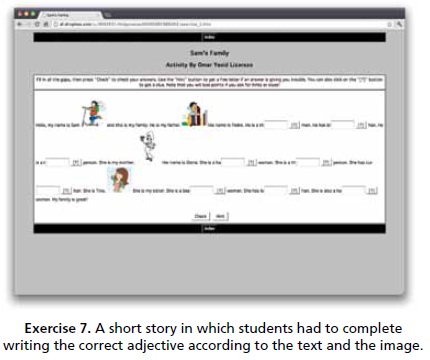
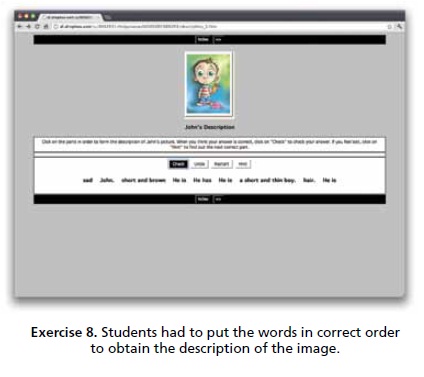
Appendix D: Final Description Posted in the Blog
Posted at: http://lizajara.blogspot.com
Appendix E: Samples of Worksheets Used Along the Project
First Worksheet
Name: ________________________________________Date:__________________________________
Adjectives Mastery
Instructions:
Adjectives are words used to describe a noun. Write an adjective on each line to describe the dog.
Write a sentence using four of the adjectives above.
- _____________________________________________________________________
- _____________________________________________________________________
- _____________________________________________________________________
- _____________________________________________________________________
Taken from:
http://www.teach-nology.com/worksheets/language_arts/adjectives/make/ver1/index.html
Second Worksheet
Name: ________________________________________Date:______________________________
Instructions:
Adjectives are words used to describe a noun. Write an adjective on each line to describe the car.
Write a sentence using four of the adjectives above.
- _____________________________________________________________________
- _____________________________________________________________________
- _____________________________________________________________________
- _____________________________________________________________________
Taken from:
http://www.teach-nology.com/worksheets/language_arts/adjectives/make/ver3/index.html
Fourth Worksheet
1. Write antonyms for the following adjectives:
Ugly ______________ Happy _______________
Tall _______________ Old _________________
Small______________ Fat _________________
Long _____________ Young _______________
2. Describe the people in the following pictures to your classmates.














